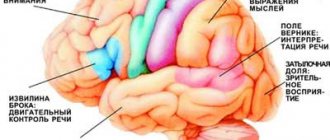31.12.2020
Many people have heard about the diagnosis of “senile sclerosis”. However, only people who have encountered this problem know what exactly it means for the patients themselves and their relatives. Senile sclerosis is called marasmus, dementia and several other terms. Let's try to figure out what the symptoms of the disease are and what care pensioners with this diagnosis need.
The essence of the disease
The word “sclerosis” is often used in everyday life. It is usually used when people complain about memory problems. However, senile sclerosis is a slightly different medical field. This disease is closely related to cerebral atherosclerosis. In young people who are far from senile dementia, difficulties in remembering some information may be associated with nervous strain, stress, and finally, impaired blood circulation in the brain due to injuries or illnesses.
Older people suffer from sclerosis due to the gradual death of brain neurons. This is a process caused by age-related changes, but it happens at different speeds for everyone. Cell death increases if a person:
- does not eat properly;
- prone to bad habits;
- moves little;
- has “bad” heredity (there were/are relatives in the family with similar problems).
The disease is indeed strongly genetically determined. DNA encodes information about all processes, including the rate of cell death. This process is purely individual. And yet, an incorrect lifestyle greatly undermines the body’s resources and reduces the number of years lived in “sober memory.” If a person is subject to physical inactivity, smokes or is addicted to alcohol, the blood vessels do not supply the brain with the amount of oxygen it needs. Because of this, neurons gradually die and sclerosis develops.
Development of the disease
Senile dementia goes through three stages in its development.
At the first stage, the patient has a decrease in intellectual abilities, he is poorly amenable to learning, but is still able to independently visit the toilet and wash himself, prepare his own food and eat it.
During the second stage, the patient degrades even more, he loses the ability to use hygiene products, a cell phone, forgets how to turn the stove on and off, and cannot independently lock and unlock the front door. However, the person can still use the toilet and bathroom independently.
At the third stage, complete insanity sets in and performing the simplest physiological processes becomes a nightmare for his family. So, the patient can relieve natural needs anywhere, he does not understand how to hold a spoon or fork and why it is necessary to turn off the gas stove or water. Constant care at this stage is vital for the patient.
Often the third stage ends in death, since any disease associated with somatic processes can lead to death.
Types of disease
“Sclerosis” is the general name for a whole group of diseases. All of them are classified according to the mechanisms of occurrence, symptoms and prognosis for the patient. There are the following types of disease:
- Multiple sclerosis. It is very common and causes severe harm to the body. With this disease, communication between brain cells and other organs and tissues is disrupted.
- Atherosclerosis. Another “popular” diagnosis now. The disease is associated with the accumulation of cholesterol and the formation of so-called “plaques” in the bloodstream.
- Cirrhosis. Poor nutrition, alcohol and drug abuse have made this disease one of the most common. When it occurs, a person's liver cells die. The disease is characterized by a severe course and leads to death in almost 100% of cases.
- Pneumosclerosis. This diagnosis is made much less frequently than the previous 3. Cell death in this case occurs in the lungs. The larger the lesions, the less oxygen gets into the blood and, as a result, into the brain.
- Thrombosclerosis. A complex disease in which the patient develops multiple adhesions, hematomas, and blood clots.
- Autoimmune sclerosis. The disease develops against the background of chronic infections and a “worn-out” immune system.
- Senile sclerosis. This type is precisely associated with age-related changes in the structure of the brain and memory loss.
Despite such a complex picture and many types of sclerosis, modern medicine copes well with their diagnosis.
What is multiple sclerosis
To people who have not encountered this disease and heard its name for the first time, it may seem that the disease is harmless and manifests itself in old age, hence sclerosis - as memory problems, and absent-mindedness - as a loss of attention and concentration. But no, the disease is much more insidious and not as simple as it might seem, and its name has a completely different meaning: in this case, “sclerosis” is a scar that appears at the site of replacement of normal nervous tissue with connective tissue, and “multiple” is the degree the spread of such scars throughout the nervous system.
As we wrote above, multiple sclerosis affects the brain and spinal cord, forming plaques that destroy the sheath of nerve fibers. The disease is chronic and cannot be cured.
Causes
Now there are a lot of means of maintaining the body in normal condition until old age. This is the level of development of medicine, and a lot of all kinds of health practices, benefits on proper nutrition, etc. Not everyone faces old age with completely destroyed health. A lot depends on the person himself. If you take proper care of your body, you can be vigorous and intellectually active even at 80 years old. Old age is not a disease, but just one of the stages of life's journey. There are many examples where people in very old age remain active, have hobbies, are interested in everything that happens in the world, and babysit their grandchildren.
At the same time, it is important to be aware of what happens to the nervous system at the age of 60 or more. The main features are:
- Deterioration of blood supply to the brain. The more years we live, the more worn out our blood vessels become. They lose elasticity and normal permeability. Cholesterol plaques and blood clots cause the brain to literally begin to “suffocate.” This is fraught with the death of neurons, and then sclerosis is just around the corner.
- Slowing down cell regeneration. In a young body, cells are formed very quickly and tissues are constantly renewed. With old age, this process slows down several times. Such “inhibition” has a bad effect on both the physical condition and the functioning of the central nervous system.
- Decreased biochemical activity of the brain. Impulses between neurons are transmitted using specific substances - neurotransmitters (dopamine, adrenaline, etc.). As a person ages, less and less of them are produced.
With a lack of neurotransmitters, impulses between cells weaken and brain function changes. This affects intellectual and physical activity. Now medical science is working to find out the exact causes of these processes. When all the answers are found, it will definitely lead to a breakthrough in the treatment of senile sclerosis and other diseases of old age.
Forgetfulness is the first sign of dementia
Sometimes, especially among people in creative professions, constant forgetfulness regarding certain everyday issues is caused by “excessive” passion for their work. If a person remains physically and mentally active, communicates adequately with others, there is no reason for concern, but sometimes memory loss is the first signal of developing senile dementia, dementia...
- Read in the article:
- What is senile sclerosis?
- Declining mental activity, senile insanity
- Dementia of old age
- Boarding house for elderly people with dementia
Symptoms of the disease
Senile sclerosis sharply reduces the patient’s quality of life and literally “rips” him out of society. This leads to depression. Symptoms of developing sclerosis are:
- Evaluate all events only in a negative way. Discussions always revolve around the topic of how everything was great before, but now it’s completely bad. Complaints come in about everything from the weather to global government conspiracies.
- Extreme touchiness. It seems to a person that no one values him, does not respect him, and wants to deceive him in something. Resentment, whims and suspicion grow like a snowball. The character is deteriorating more and more. In fact, this is not “character” at all, but a symptom of a serious illness.
- Progressive forgetfulness. Patients with senile sclerosis often perfectly remember events 15 years ago, but at the same time forget what they ate for breakfast today.
- Any excitement leads to surges in blood pressure and heart attacks. Due to excessive psycho-emotional vulnerability, an elderly patient perceives any negative event as a universal catastrophe. This leads to increased pressure, overloading blood vessels and the heart.
- Frequent migraines, pain in the back and limbs. When a person is depressed, their pain threshold decreases. What previously seemed like a minor ailment is now very difficult and painful.
Are these signs present in your grandfather or grandmother? It's time to make an appointment for your relative to see a neurologist or psychiatrist! The sooner the diagnosis is made, the better. Brain cells can be destroyed very quickly, so it is important to start treatment early. If the problem is detected at an early stage and treated correctly, the patient’s condition can change dramatically. Heart problems will be less likely to occur. The person will become noticeably more active. Even his view of the world will change. Endless complaints and periods of despondency will disappear.
If the disease was diagnosed at a later stage, serious changes (sometimes irreversible) almost certainly occurred in the nervous system. When a significant portion of the frontal lobe neurons die, a person experiences:
- causeless anxiety;
- depression;
- aggressiveness;
- senile egoism;
- insomnia;
- memory losses;
- illogicality in reasoning;
- inability to perceive new information;
- disorientation in time/space.
All these signs indicate that an elderly person has deep senile sclerosis. Brain cells in this state die rapidly. At the next stage of sclerosis, the patient becomes delirious and hallucinates. Sometimes he will even completely lose control of himself: he becomes overexcited for no reason, loses touch with reality, may leave home and forget where he came from and where he was going.
Types and forms of multiple sclerosis
There are three forms of multiple sclerosis based on the location of the plaques:
- spinal form - damage to the spinal cord;
- cerebral form - brain damage;
- cerebrospinal – mixed form, in which both the brain and spinal cord are affected.
Multiple sclerosis is also classified according to the course of the disease:
- remitting-progressive type of the disease. The most common type of multiple sclerosis. Differs in periods of exacerbation and remission. The duration of the periods is individual for each patient. Much depends on the therapy used, which can prolong remission and significantly alleviate the patient’s condition during an exacerbation of the disease;
- primary progressive type. A rare type of disease, which is characterized by vivid symptoms from the very beginning. In this case, the patient’s health condition deteriorates gradually, the rate of progress of the disease varies from person to person;
- secondary progressive type of disease. It occurs in patients in whom quite a lot of time has passed since the first period of exacerbation (10-15 years). Health deterioration occurs more slowly than with other types of multiple sclerosis;
- progressive with exacerbations. In this case, the disease develops very quickly, affecting more and more areas of the nervous system with sclerotic plaques. This type is, fortunately, rare.
Diagnostics
Only a qualified neurologist can make a correct diagnosis. In addition to studying the history and complaints of a potential patient, a whole range of studies is carried out:
- MRI;
- blood analysis;
- study of cerebrospinal fluid.
When planning an examination, the patient’s relatives should choose only specialized medical centers with the appropriate level of staff training.
How to increase cerebral reserve
Mental activity, fine motor skills and physical activity will help with this. Such measures are especially effective in preventing cognitive impairment [11,18–19].
Try to read more, solve crosswords, puzzles, and sometimes play computer games. Organize your vacation so that intellectual activity takes place there. It is known that during times of stress, most people find it more difficult to think. It's good if you manage to find an activity that would keep your mind in good shape, but would not cause stress. With such training it will be easier for you to cope with real mental loads. For example, you can install counting, memory, and word search games on your smartphone.
Study and work itself supports cerebral reserve. You should not indulge in idleness and take long breaks unnecessarily. In old age, you should also not neglect intellectual activity. If cognitive function is compromised, maintaining mental tone should be a priority.
Intelligence can also be developed through the body. Both fine and gross motor exercises improve cognitive function [18]. The mechanism of their action differs in many ways; different neural networks are involved. However, there is something in common.
During one or another physical action, a person also performs cognitive tasks. He orients himself in space, makes decisions, counts, analyzes, and remembers. Physical activity reinforces these processes with the release of pleasure mediators - endorphins, dopamine, serotonin. This way, successful actions are encouraged, and motivation is established not only to move, but also to think.
Handicrafts, drawing, writing or typing, and playing musical instruments help develop fine motor skills. Massage and finger exercises also stimulate the nervous system, including the cognitive departments.
Experts recommend that people with multiple sclerosis engage in sports on a regular basis. Coordination exercises, dancing and walking work well. The main thing is that the person likes them and is able to fulfill them [19]. Regular training is best for improving working memory [18].
Treatment of senile sclerosis
It should be clarified right away: if treatment is started on time, the chances of stopping the destruction of neurons are very high. Therapy takes a long time, but it's worth it. Relatives should be patient and provide the patient with maximum psychological support. Since the disease affects many body systems (heart, blood vessels, etc.), complex treatment is necessary. The participation of a neurologist, cardiologist, and psychotherapist will be required. The patient’s relatives will have to monitor the regularity of his medications and the strict adherence to doctors’ orders. As a last resort, hospitalization is used.
During the examination, doctors find out what led to brain degradation:
- hypertension;
- Heart arythmy;
- increased blood clotting;
- stroke;
- cholesterol plaques;
- Alzheimer's disease.
Depending on the prerequisites, the type of treatment is prescribed. Typically used:
- medicines;
- diet;
- normalization of the daily routine;
- feasible physical activity;
- psychotherapy.
Prevention of multiple sclerosis
- Healthy lifestyle: giving up bad habits, proper nutrition, frequent walks in the fresh air, moderate and feasible physical activity, healthy sleep.
- Avoiding stressful situations and depression.
- Reducing infectious diseases through preventive measures and compliance with sanitary and hygienic standards.
And the most important thing is to seek medical help in a timely manner. Old age does not give a reason to endure and ignore even a headache, because even it can be a harbinger and the first sign of a serious illness. Older people should listen more carefully to their body and undergo periodic medical examinations and medical examinations. After all, any disease is much easier to prevent than to treat.
Be healthy!
Drug treatment
Typically therapy involves taking psychostimulants. These are drugs of the caffeine group that have a tonic, stimulating effect on brain activity. To suppress aggression and enhance intellectual activity, patients are also prescribed nootropic medications. To correct psycho-emotional reactions, a patient with senile sclerosis is prescribed tranquilizers. They relieve anxiety. In parallel with drug therapy, the patient almost always receives psychotherapeutic treatment. Consultations with a neuropsychiatrist help you adapt to the complexities of the disease and have a positive attitude towards treatment. Folk remedies against senile sclerosis
How sclerosis progresses
The development of the disease occurs in three stages:
- The formation of the disease, the occurrence of an inflammatory reaction in the central nervous system.
- Damage to the myelin (protective) sheath.
- Continuous destruction and death of nerve cells.
The inflammatory process is accompanied by the appearance of plaques, the sizes of which vary from a couple of millimeters to several centimeters. As the disease progresses, they can grow together. Plaques can be active and old - the name determines the degree of activity. They arise in the white matter, the main component of the central nervous system, where the myelin covering is located. The moment plaques begin to form in areas of the spinal cord, cerebellum and optic nerves, symptoms multiply. Despite the exacerbation of the pathological process, the disease is characterized by frequent remissions caused by periodic restoration of the myelin layer. At this point, the symptoms subside and the patient’s condition improves, but rarely does this period last more than a month. As the disease progresses for the worse, myelin is restored with great difficulty, and sclerosis will progress over several weeks.
Garlic
Excellent for senile sclerosis. It should be consumed in the form of an alcohol tincture. It is made in a dark glass container. A third of the bowl is filled with finely chopped garlic, and 2/3 with alcohol. The tincture is kept for 2 weeks. All this time she must stand in a dark place. The container must be shaken daily to prevent the formation of a thick sediment. Upon completion of the process, take 5 drops of the tincture (dissolve in a teaspoon of clean water) before meals. The product stabilizes blood pressure and cleans blood vessels.
Treatment of cognitive impairment
It is not always possible to fully restore cognitive function. In most cases, therapy is aimed at compensating for an existing deficiency and adapting the patient. It is important to prevent serious cognitive impairment in time and prevent dementia from developing. Therefore, the main role is given to timely diagnosis [4].
The next stage is adequate treatment. The decision to select the pharmacological group of a drug and the course of treatment is very important, since many factors must be taken into account. It is taken by the attending physician.
Drug therapy for cognitive functions is aimed at [4,14–17]:
- Slowing down the pathological processes of multiple sclerosis .
The most obvious protection of nervous tissue in MS is provided by DMTs. Because nerve circuits can be repaired by other neurons, it is important to reduce nerve tissue destruction and inflammation in the brain. This creates the ground for compensation processes and reduces the rate of development of cognitive impairment. But there is also a downside. Although DMTs prevent severe cognitive impairment, they may have side effects and partially impair mental performance through other mechanisms. However, the benefits of taking DMTRS are incomparably higher, and side effects should not serve as a reason for discontinuing the drug on your own. If they appear, you should discuss the issue of symptomatic treatment with your doctor [14]. - Treatment of depression, anxiety, insomnia and other psycho-emotional disorders that worsen cognitive functions. Antidepressants, sedatives, anxiolytics, stimulants, etc. are used.
- Elimination of imbalance of neurotransmitters - dopamine, glutamate, acetylcholine. For correction, drugs of various groups are used, including donepezil, memantine, choline alfoscerate, glycerophosphate. The course of treatment is usually long, lasting six months or more. It is important to observe regularity and be under medical supervision [4, 15].
- Restoration of cerebral circulation , which is especially important in the presence of vascular disorders. Much attention is paid to improving metabolism , in particular replenishing energy reserves.
- Protecting nervous tissue from the negative influence of various molecules, increasing the safety margin. Drugs are used to strengthen the membranes of nerve cells (phosphatidylserine [16]), eliminate free radicals (thioctic acid [17]), and reduce the need for oxygen in conditions of its deficiency.
The doctor may prescribe a drug with a complex effect. Some drugs combine both protective and metabolic properties. The drugs can simultaneously improve blood flow to the brain and improve the balance of neurotransmitters. Many of them belong to the group of nootropics.
Ethylmethylhydroxypyridine succinate (Mexidol), polypeptides of the cerebral cortex of cattle (cortexin) [16], piracetam, ginkgo biloba extract [15], cerebrolysin, citicoline [17], etc. have a complex effect.
Other treatments
The success of drug treatment largely depends on auxiliary means and techniques:
- The patient should be protected from anxiety as much as possible. Stress impairs memory. Rest, on the contrary, has a very positive effect on the capabilities of the brain.
- Family support and general belief in the success of treatment increase its effectiveness.
- The patient must be awakened to interest in life. Maximum involvement in family affairs and communication in a positive way gives excellent results.
- In order for information to remain in memory, the patient needs to concentrate more actively on it. When absorbing large amounts of knowledge, you should take rest breaks. This way, the brain will better “sort out” everything new.
- Reading is a great memory training activity. Moreover, this process must be properly organized. In order for the information contained in a book to be imprinted in your memory, after reading you should analyze the work or discuss it with someone. Think about what you learned that was useful, what was particularly exciting or controversial.
- Planning has a good effect on thought processes. Every evening you need to make a plan for the next day (even if such trivial events as going to the grocery store are expected).
- Learning songs and poems and mastering foreign languages trains the memory perfectly.
Treatment
How to treat sclerosis is not an entirely correct question, since it is impossible to cure it, but you can only stop the development of the disease. After all, as was said earlier, nerve cells do not recover. It is for this reason that the sooner a patient seeks help from a specialist, the better and more effective medical care he will receive.
Watch video: senile dementia or senile sclerosis
The basis of treatment, in addition to the so-called memory medicine, is nootropic drugs. This remedy for sclerosis is aimed at improving the cognitive functions of the body and stimulating cerebral circulation.
It is worth remembering that despite the good tolerability of drugs in this group in adulthood, some problems may arise if the pills were not prescribed by a doctor.
Since with age the walls of blood vessels become thinner and the risk of their rupture increases, an integral part of drug therapy is taking medications that strengthen blood vessels.
As an additional medicine for sclerosis, drugs containing caffeine and nicotinic acid are used. It would also be a good idea to take vitamins, which are useful at any age.
To eliminate some symptoms of the disease, special medications are prescribed. Thus, antidepressants are indicated to relieve a nervous breakdown, and even tranquilizers can be used to bring a person to his senses.
An important component of treatment is the involvement of relatives in this process. Since the presence of psychological comfort is the key to a long life for the patient.
In the later stages of the disease, memory pills alone are not enough; it is necessary to involve a specialist in psychiatry in the treatment, who may make some adjustments to the treatment plan and prescribe additional medications.
Types of sclerosis
Medicine does not know such a thing as “brain aging.” There is only a classification of sclerosis, which depends on the degree of narrowing of the diameter of the vascular channels and the presence of mechanical barriers to normal blood flow.
There is no single classification, however, it is possible to identify the main varieties that are considered generally accepted in medical practice in different countries.
According to the factors provoking the occurrence of pathology:
- multiple sclerosis is one of the most common types; large areas of the myelin sheath of the nerve fiber are damaged, which leads to a failure in the movement of impulses;
- atherosclerotic type - occurs against the background of an excess of “bad” cholesterol and an abundance of cholesterol plaques on the walls of blood vessels;
- pneumosclerotic variety - appears due to the presence of pathologies of the respiratory system (the volume of oxygen molecules entering the brain decreases).
By age of development:
- early sclerosis - usually develops against the background of the disseminated variety, young people can also get sick, usually manifests itself in the form of intellectual “failures” that do not allow normal work activity;
- middle-aged sclerosis - develops against the background of any chronic pathologies (for example, diabetes), which lead to a deterioration in blood supply to the brain;
- senile sclerosis - develops in older people, accompanied by the active transformation of large parts of blood vessels into connective tissue.








